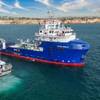Insights with Gibbs & Cox President, Rick Biben
By Raina Clark, from the December 2010 edition of MarineNews
MarineNews spoke with Rick Biben, Chief Executive and President of Gibbs and Cox, Inc., about his background in the industry, the state of the naval design market, how his company is investing for the future and technological and design advancements in the field.
What is your background in the industry?
After college (Bryant University, 1972, BS Management) I went into the U.S. Peace Corps (Ecuador, 1972 – 1975) for about three years. I left the government and entered the contractor community in 1979.
I was with Syscon Corporation from 1981 through late in 1999. The company changed ownership a couple times until Northrop Grumman eventually purchased it. I moved for the company from the Washington, DC area to the Newport, R.I. area in 1985, and then moved from R.I. on to San Diego in 1997. As a result I learned a great deal about a very broad customer and technology marketplace from ASW through C4ISR, from platform engineering to modeling, simulation and training systems to information/network security.
In 1999 I was recruited to another company, then named Anteon Corporation (now part of General Dynamics), as Sr. Vice President and Group Manager to lead their west coast operations. I stayed with Anteon until early 2004 when I moved over to Computer Sciences Corporation (CSC) and led their Naval Information Systems organization in San Diego until late 2006.
In December of 2006 I was recruited by Science Applications International Corporation (SAIC) as the Sr. Vice President of their Integrated Systems and Solutions organization. In mid 2008, SAIC asked me to move back to the east coast/Washington DC area and manage a sizeable organization with the objective of business expansion and diversity. My greatest accomplishment in that role was to transform a large management team, which had been reporting to as many as seven separate managers, into a cohesive and very successful team — one that I know will continue to be successful for years to come.
I was honored to have been selected as the Chief Executive and President of Gibbs and Cox, Inc. this past July and have had a really great experience meeting our employees, customers and industry partners over just the last few months or so.
What is the outlook for your market right now?
The market continues to evolve, that is certainly one of the reasons for our diversification plans at Gibbs and Cox. In terms of new ship construction for the larger platforms that Gibbs and Cox has historically been heavily involved in, we have seen program cancellations (CG (X)), decreased production (DDG 1000) and numerous program delays. The cycles and oscillations of this type of work therefore have changed and the new start peaks have moved further apart. We are looking at other areas such as engineering studies and services for the government, platform sustainment and improvement, and commercial opportunities, to decrease the depths of the valleys and adjust the peak leveling for the future.
How is your company investing for the future?
Gibbs and Cox is really one of the last independent naval architecture and maritime engineering companies of its size. Our company is nearly 82 years old now and has a phenomenal background including the design and engineering of over 6,000 naval and commercial ships, nearly 80% of the current U.S. Navy’s surface combatant fleet. We are proud to be the design agent supporting the Lockheed Martin team for the Littoral Combat Ship (Freedom class). We fervently believe that our team provides the best solution for the USN in many aspects of value, total cost of ownership, and sustainability.
We are working to diversify our business base and expand further into the engineering services for our current customers with the USN, USCG, and industry (domestic and international). We are focusing a large amount of our growth potential towards that direction. We are in the act of hiring a new Vice President of Business Development with significant focus towards growth in that arena. We are also working to expand our presence in the commercial marketplace. I have spent a lot of start-up time meeting with our partners in the industry, such as BAE/Atlantic, Bollinger, Colonna, Fincantieri/Marinette, GD/BIW, Signal International/Bender, Todd, Vancouver, VT Halter, toward that end. We are also realizing a significant amount of success working with our U.S. Navy customers, such as NSWC CD/Philadelphia, NSWC Dahlgren and the NAVSEA enterprise, on ship sustainability areas. We are just starting up a great new project with the Missile Defense Agency as well.
Lastly, we are involved with and investing in a number of programs in the energy-related areas such as power consumption and utilization, “green ship,” and alternative energy. We are also investing in areas such as Computational Fluid Dynamics (CFD), composite materials, and a variety of design models.
What have been the most important technological and design advances in the last few years?
Over the years we have seen high performance hull forms moving into mainstream surface Navy and commercial components and equipment in the military. We have gone from closed, proprietary/federated architectures to integrated, open architecture systems, even for mission systems. We have seen, and continue to be challenged by, power consumption issues not only for mission systems, but also for propulsion and auxiliaries and now, of course, the resultant challenge to improve consumption and seek alternative sources.
Concerns for increased shipboard quality of life and habitability issues have become more forefront issues then years past.
Overall computer technology improvements have really brought on changes and improvements across the board — from design and engineering, structural analysis, stability through radar systems (Aegis AN/SPY-1), navigation, communications, command and control, and weapons performance. I should include computational fluid dynamics (CFD) as an additional technology enhancement — again, without the computer technology advancements, CFD applications and calculations would have been less possible.
What technological and design advances need to be made?
The short answer is that the key areas are in energy/power and materials. In terms of power, I am including energy sources such as alternative and improved energy products (nuclear, improved electrical, superconducting motors and generators, storage and distribution, fuel cells, batteries, etc.), the focus being reduction in power consumption. In the area of materials, the focus should be on improved composites for strength/durability (shock). Associated weight issues, of course would also improve energy/power concerns. Also materials that are more fire resistant/retardant are necessary. There are trade-offs that need to be analyzed and considered in areas such as reliability versus cost, but the analysis should continue to be on the life cycle aspects — total cost of ownership, rather than just the short term in order to really calibrate the value of the investment.
















